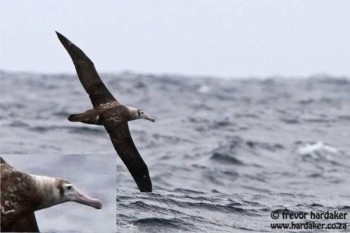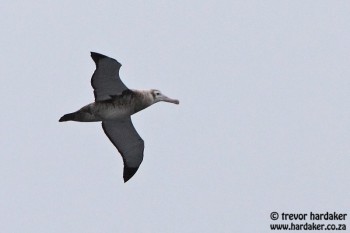The Critically Endangered Amsterdam Albatross Diomedea amsterdamensis is very rarely seen at sea, because of its rarity, a breeding range restricted to France’s Amsterdam Island in the southern Indian Ocean, and the difficulty of separating it at sea convincingly from the other species of great albatrosses in the genus.
A recent record confirmed by photographs in South African waters is thus noteworthy. The bird was seen on 13 July this year near Cape Point in the Western Cape while on a Zest for Birds pelagic bird-watching outing.


The South African sighting photographed by Trevor Hardaker
The following account confirming the identification is reproduced with permission from Trevor and Margaret Hardaker’s blog following minor editing.
“Our voyage homewards was back into overcast conditions, but was entertainingly punctuated by regular visits from Soft-plumaged Petrels [Pterodroma mollis], and it was when watching one of these at only six nautical miles from Cape Point that a huge dark brown bird got up off the water some 150 m or so off the starboard bow. Calls of “juv Wanderer” immediately went up from the guides and cameras were lifted and snapping away as this graceful giant flew level for a short while before heading off to the south-east. Immediately, something did not feel “right” about this bird and we carried out the mandatory review of pictures immediately and realised that there was something seriously amiss with this bird. Despite its overall brown “monkey jacket” type plumage and white face, it showed a glaring broad white hind collar that contrasted with a dark brown cap and ear covert line, and a broad white belly. Closer examination appeared to reveal a dark cutting edge and dusky tip on the bill, near diagnostic features of the critically endangered Amsterdam Albatross. Subsequently, the photos were sent off to a number of experts across the globe and the following passage is a direct quote from the Southern African Rare Bird News Report a few days later:
“We have finally reached a point, after having done some very thorough research into the various possibilities and communicated with a number of people on the issue, to announce that we now believe that the bird we saw and photographed about 6 nautical miles south-west of Cape Point on Saturday, 13 July 2013 was, in fact, an Amsterdam Albatross! We have not taken this decision lightly and have discussed the issue ad nauseum with a number of people. It seems wrong, when so many people have given detailed and valuable input on the bird, to single out just a few, but there are three people who certainly should be mentioned and who all add definite weight to the credibility of the record.
The first two are the world’s leading seabird identification authorities, Hadoram Shirihai and Peter Harrison, both of whom have confirmed that they are happy, based on the latest understandings of identification criteria (much of which is not even published in literature yet!), that all other possible candidates can be eliminated and the bird is definitely an Amsterdam Albatross. The third person that deserves a mention is Jean-Paul Roux, the person who wrote the paper originally describing Amsterdam Albatross to science, and he, too, has come back to confirm the identification as that species! We could not have asked for a better vote of support for this record than from these three gentlemen!
This is a hugely significant record of a species that is classed as “Critically Endangered” with current population estimates sitting at a maximum of 170 individuals left in the world! I still have to check this, but it may well be the rarest species (on a global scale) that has ever been recorded in Southern Africa. Although this species has been satellite tracked into our waters before, there has never been a sight record that has been confirmed up until now. We count ourselves as truly fortunate to have been on board when this really special bird came to visit the boat and are extremely thankful that we managed to get photographs of it which were able to confirm the identification. Big smiles all round…:)”.

An Amsterdam Albatross off Amsterdam Island, photographed by Mark Zufelt
Click here to see more photos of Amsterdam Albatrosses at sea close to Amsterdam Island by Mark Zufelt.
With thanks to Trevor Hardaker, self-styled wildlife enthusiast and photographer.
John Cooper, ACAP Information Officer, 12 August 2013

 English
English  Français
Français  Español
Español